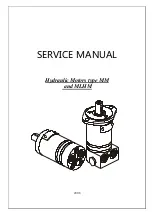
10.9
Section 10
Internal Components
10
Overheating:
An exhaust valve subject to
overheating will have a dark dicoloration in the area
above the valve guide. Worn guides and faulty valve
springs may cause this condition. Also check for
clogged air intake, blocked fins, and lean fuel mixture
when this condition is noted.
Valve Guides
If a valve guide is worn beyond specifications, it will
not guide the valve in a straight line. This may result
in burnt valve faces or seats, loss of compression, and
excessive oil consumption.
To check valve guide-to-stem clearance, thoroughly
clean the valve guide and, using a split-ball gauge,
measure the inside diameter. Then, using an outside
micrometer, measure the diameter of the valve stem at
several points on the stem where it moves in the valve
guide. Use the largest stem diameter to calculate the
clearance. Compare measurements and clearance to
the specifications listed (See Figure 10-10) for the
individual model involved. Determine whether the
valve stem or the guide is responsible for the excessive
clearance. The valve guides are not replaceable.
Valve Seat Inserts
The valve seats are not replaceable. If the seats become
badly pitted, worn, or distorted, the inserts can be
reconditioned.
Use a standard valve seat cutter (see Figure 10-11) and
cut seat to dimensions shown in Figure 10-10. (Valve
details illustration.)
Figure 10-11. Standard Valve Seat Cutter.
Lapping Valves
Reground or new valves must be lapped in, to provide
proper fit. Use a hand valve grinder for final lapping.
Lightly coat valve face with
fine
grade of grinding
compound, then rotate valve on seat with grinder.
Continue grinding until smooth surface is obtained on
seat and on valve face. Thoroughly clean valve and
cylinder head in soap and hot water to remove all
traces of grinding compound. After drying, apply a
light coating of
SAE 10
oil to prevent rusting.
Intake Valve Stem Seal
These engines use a valve stem seal on the intake
valve. Always use a new seal when the intake valve is
removed from the cylinder head. The seal should be
replaced if deteriorated or damaged in any way.
Never reuse an old seal.
Figure 10-12. Valve Stem Seal.
Valve Seat
Cover (Typical)
Pilot
Summary of Contents for Command PRO CS
Page 1: ...6 59 0 18 25 217 5 1 6 7 200 1 352 6 3...
Page 2: ......
Page 4: ......
Page 11: ...6HFWLRQ 6DIHW DQG HQHUDO QIRUPDWLRQ 6WRUDJH...
Page 15: ...6HFWLRQ 6DIHW DQG HQHUDO QIRUPDWLRQ HQHUDO 6SHFL FDWLRQV...
Page 17: ...6HFWLRQ 6DIHW DQG HQHUDO QIRUPDWLRQ RQQHFWLQJ 5RG FRQW UDQNFDVH UDQNVKDIW...
Page 18: ...6HFWLRQ 6DIHW DQG HQHUDO QIRUPDWLRQ UDQNVKDIW FRQW OLQGHU RUH OLQGHU HDG OHFWULF 6WDUWHU...
Page 20: ...6HFWLRQ 6DIHW DQG HQHUDO QIRUPDWLRQ 3LVWRQ 3LVWRQ 5LQJV DQG 3LVWRQ 3LQ FRQW...
Page 50: ...6HFWLRQ XEULFDWLRQ 6 VWHP...
Page 56: ...7 6 Section 7 Retractable Starter...
Page 92: ...8 36 Section 8 Electrical System and Components...
Page 128: ...10 16 Section 10 Internal Components...
Page 161: ......
















































